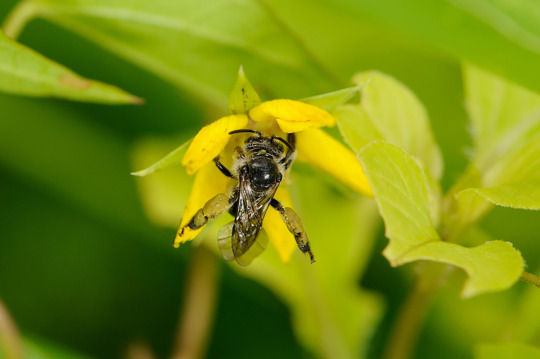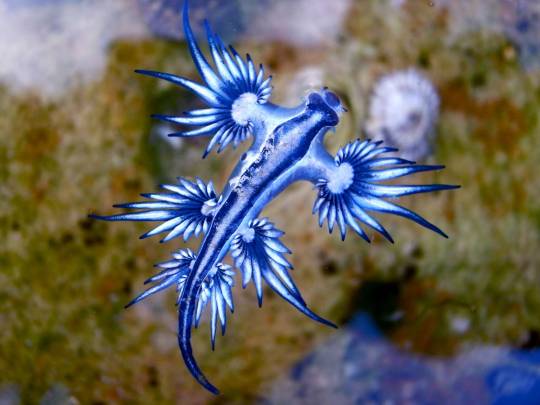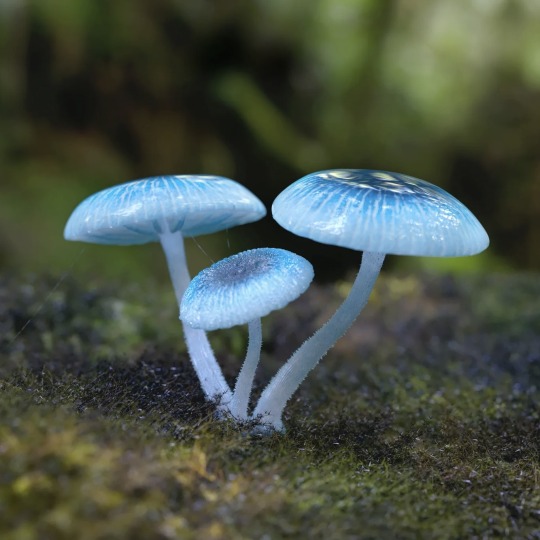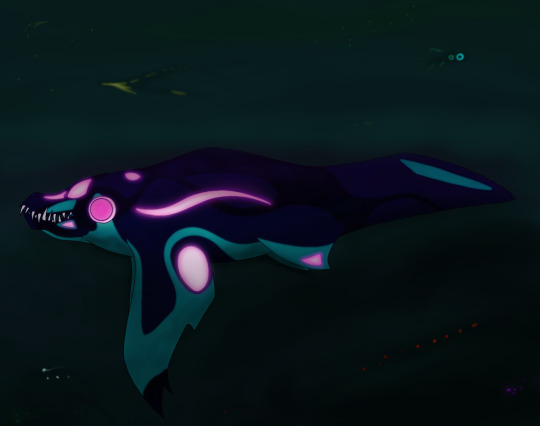#BLUE ECOLOGY
Text

Xerces Society: Announcing The State Of The Bees Initiative: Our Plan To Study Every Wild Bee Species In The U.S.
This is really exciting news! For those unaware, the Xerces Society has been focusing on invertebrate conservation for over fifty years, and has pioneered a lot of the work to bring awareness to the devastating losses of not only insects but other terrestrial and aquatic invertebrates. It gets its name from the Xerces blue butterfly (Glaucopsyche xerces), the first North American butterfly driven to extinction by human activities.
Even if you haven't heard of the Xerces Society, you've probably come across various "Save the Bees!" campaigns. These frequently focus on the domesticated European honey bee (Apis mellifera), which, while it may be important to crop pollination in many parts of the world, is not a part of natural ecosystems in places like the Americas and Australia, and can be considered an invasive species at times. With the rise of colony collapse disorder (CCD) particularly after the turn of the 21st century, where entire domestic honeybee colonies would die off, the need to preserve bees began to gain wider public acknowledgement.
But what many people don't realize is that it is the thousands upon thousands of other native bee species worldwide that are in greater danger of extinction. They don't have armies of beekeepers giving them safe places to live and treating them for diseases and parasites. More importantly, where honey bees may visit a wide variety of plants, native bees often have a much narrower series of species they visit, and they are quite vulnerable to habitat loss. Most bees are not as social as honey bees and live solitary lives, unseen by the casual observer.
Invertebrates in general often suffer from a lack of conservation information, meaning that particularly vulnerable species may fly under the radar and risk going extinct without anyone realizing until it's too late. This ambitious program by the Xerces Society aims to solve that problem, at least for the 3,600+ species of bee in the United States. If they can assign a conservation status to each one, then that strengthens the argument toward protecting their wild habitats and working to increase their numbers. Hopefully it will also prompt more attention to other under-studied species that are in danger of going extinct simply because we don't know enough about them.
#bees#save the bees#invertebrates#arthropods#insects#entomology#nature#wildlife#animals#ecology#environment#conservation#science#scicomm#endangered species#extinction#pollinators#Xerces Society#Xerces blue
590 notes
·
View notes
Text

My friend took a picture and let me paint it. I love the shadows! I think it is a blue jay? Female perhaps?🤔
#artists on tumblr#watercolor#belles art#ecology#biology#wildlife#birds#birds nature#birding#art#blue jays
263 notes
·
View notes
Text

#sharia law#vote biden#vote blue#vote democrat#please vote#voting#election 2024#project 2025#science#geology#biology#ecology#stem#environmental science#women's rights#trans rights#human rights#reproductive rights#animal rights#abortion rights#capitalism#political#politics#abortion#reproductive freedom#abortion is healthcare#reproductive justice#bodily autonomy#lgtbqia+#lgtbq community
78 notes
·
View notes
Photo

water lily dream ✸ part of a growing collection! (2/7) 🌷🌈
#illustration#plants#aesthetic#botany#water lily#stamp#queer ecology#washi#stars#moon#magical#blue#pink#botanical#digital art#art ph#art fart#prinsomnia#portfolio#the washi station
435 notes
·
View notes
Text

Some sexual differences between the female and male Ologs. Males have an upturned face that makes them constantly look angry and if it wasn’t obvious enough their bright blue colouring that runs down from their face to their body. Males have a noticeable large plum body making them look like a little vibrant tennis balls, this makes them unevenly balanced as they are top heavy due to their long slim tails.
If it wasn’t for their wings which have more than one purpose mainly used for mating dances and to balance that little body. Another thing unique between the female and males is their complete different ways of locomotion, where males prefer to hop fitting to their body build making it easier to move without tumbling down while females prefer to run normally though they do tend to hop time to time keeping their long foot claws off the ground.

Females are a tad bit larger than your typical southern male Olog, having body’s that are are evenly balanced due to their much longer and thicker tails. This allows for much smaller and less visible wings making them less noticeable for predators. They have down turned eyes giving them the appearance of constantly being sad even though this might not be the case.
Compared to males they have much smaller antennae giving them less sensory input though this does not make them useless, as they serve the same purpose (picking up on chemical differences in the air). They have 2 large nails used for digging and barrow as females are responsible for creating miniature underground connections, where many female Olog create working communities underground, helping each other out and alerting each other of outside threats. Females have also been found to have larger brains though it hasn’t been observed that size difference makes any significant differences to intelligence.

Here’s the size differences, I’m doing this in Pepsi can math for a better visual representation and coz I can’t do math for shit.

Also a shout out to this little Olog taking he’s shot with the ladies.
#spec bio#speculative biology#speculative evolution#alien species#artists on tumblr#spec evo#speculative fiction#xenobiology#speculative ecology#speculative worldbuilding#ologs#worldbuilding#oooo get it blue boy‼️‼️‼️
90 notes
·
View notes
Text

A continuation of my post season 8 Black Paladin Lance AU. I’m trying to keep things close to canon with the other characters but am open to divergent suggestions.
#lance mcclain#pidge gunderson#pidge holt#vld pidge#voltron#voltron fanart#vld fanart#voltron legendary defender#katie holt#green lion#green paladin#black paladin lance#Black paladin! Lance au#blade of marmora#voltron pidge#green bayard#post season 8#blue paladin#red paladin#ecology#conservation#technology#innovation
96 notes
·
View notes
Text
Wet Beast Wednesday: blue whale
It's the one-year anniversary of my Wet Beast Wednesday posts. My first post was on the smallest of all cetaceans, the vaquita. For the anniversary, I'm going to go to the other end of the spectrum and cover the largest of all cetaceans: the mighty blue whale. Join me as we explore the biggest of bois, the largest of lads, and the absolutest of units.

(Image: a blue whale at the surface of the ocean, seen from above. It is long, slender, and grey. The head is the widest point and takes up about a quarter of the body. The blowholes are positioned at the back of the head. Two flippers emerge from the body just behind the head. The tail fluke is very broad and pointed. End ID)
Blaenoptera musculus, the blue whale, is divided into four subspecies based on size and location. These are the northern blue whale (B. m. musculus), the north Indian ocean blue whale (B. m. indica), the antarctic blue whale (B. m. intermedia), and the pygmy blue whale (B. m. brevicauda). The northern and pygmy whales are further subdivided into population stocks based on what part of their range they live in. Blue whales are not only the largest cetaceans, they are the largest known animals to have ever existed. There are animals that can get longer, like the lion's mane jellyfish, but blue whales are the most massive animals. There are some extinct species that could potentially meet or exceed the blue whale in size, including some ichthyosaurs, whales, and sauropods, but all those species are known only from skeleton fragments so we can't get a fully accurate estimate of their size. Size varies depending on subspecies and population stock, but the longest group are the eastern north Pacific population, which can reach an average 24 m (79 ft). The antarctic subspecies is the heaviest, averaging 130 metric tons (290,000 lbs) for females. Females are larger than males. The pygmy subspecies is the smallest, though small is a relative term as they can still average 21.3 m (69.9 ft) and 99 metric tons (218,000 lbs). The longest scientifically measured individual was 30 m (98 ft), though there are unconfirmed reports of longer ones. The heaviest blue whale on record weighed 173 metric tons (381,400 lbs), though there are whales estimated to get up to 199 metric tons (438,720 lbs). Blue whales also have the largest hearts of any animal. One specimen measured in at 180 kg (400 lbs). The heart is about the size of a golf cart and 4 or 5 people could fit inside the chambers without having to squeeze. There's a commonly-quoted factoid that a person could swim through a blue whale's arteries without touching the sides. I wasn't able to find any exact measurements to confirm or refute this. I did find some sources saying that the blood vessels are highly elastic so its possible the factoids are talking about the arteries at their most stretched. Each heartbeat moves 220 liters of blood and the total blood volume is estimated at 5,300 liters. The heartbeat can be heard two miles away. I really just want to impress on you that these animals are fucking massive. A study on hydrodymanics suggested that a blue whale couldn't get longer than 33 meters (108 ft) before its metabolic and energy requirements would exceed the amount of food it could eat. Blue whales are verging on what is theoretically the maximum amount of big a whale can be.

(Image: an illustration comparing the size of a blue whale to other animals and showing their size. The whale is about as long as a line consisting of a polar bear, grizzly bear, human, asian elephant, giraffe, and great white shark. End ID. Source)
Blue whales are baleen whales, meaning that instead of teeth they have thick, keratinous plates called baleen attached to the upper jaw. When feeding, blue whales open their mouths and swim through clouds of krill. The mouth can open to 80 degrees and folds at the bottom let it expand to fit 220,000 liters of water at a time. The whale them closes its mouth and forces water out through the baleen. The baleen acts as a sieve, trapping krill in the mouth to be swallowed. Blue whales target patched of krill with the highest densities as their feeding style requires a minimum of 100 krill per cubic meter to offset the energy cost of feeding. Most mouthfuls provide 8,312 to 475,141 kilocalories of energy, more than enough to offset the cost of feeding. The current estimate for how much krill an adult needs in a day is 1,120 ± 359 kg (2,469 ± 791 lbs) and pregnant females need even more than that. Blue whales will dive in search of food, with the deepest confirmed depth being a pygmy blue whale that reached 506 m (1,660 ft). The deepest known dive from a non-pygmy blue whale was 315 m (1,033 ft). The longest recorded dive was 15.2 minutes and the estimated maximum dive duration is 31.2 minutes. During dives, a blue whale's heartbeat slows to 2 beats per minute, the slowest of any known animal. The elastic aorta seems to take over a lot of the heart's pumping job during this time. Blue whales are streamlined and similar in appearance to the relates sei whales and fin whales. Blue and fin whales are capable of hybridizing and producing fertile offspring. 3.5% of the blue whale genome comes from hybridization with fin whales. While blue whales can produce hybrid offspring with fin whales, the reverse is not true and the gene flow from fin to blue is unidirectional. It appears that all hybrids are the result of a fin father and a blue mother. Interestingly, blue whales do not appear to be capable of hybridizing with the more closely related sei whales. There are unconfirmed reports of blue whale and humpback whale hybrids. And because someone was going to bring it up if I didn't, the blue whale's penis is the largest of any animal at 3 m (9.8 ft) long and 30 cm (12 in) wide and they can release an estimated 17 liters of semen at a time. I know someone out there desperately wanted to know that and to that person I say you're whalecum.

(Image: a blue whale feeding at the surface of the ocean on its side, seen from above. The mouth is open with the troat and lower mouth inflated. It is swimming into a patch of krill, visible as yellowish coloration in the water. End id)
Blue whales can be found worldwide, though they typically prefer colder water and do not enter the Arctic ocean. They are usually solitary or travel in pairs, but can gather in groups up to 50 strong when food is abundant. Many are migratory, feeding in cold water during the summer and moving toward the equator in winter. They can follow complex migratory patterns that have to be memorized. There are multiple different strategies employed by different populations regarding who migrates when and some populations don't migrate at all. Their vocalizations are used for long-distance and short-range communication and scientists have classified multiple different types of sounds produced. Different populations of whales have different patterns of vocalizations which may be akin to languages or dialects. Blue whale sounds are some of the loudest and lowest frequency produced by any animal and most are too low-frequency to be audible to humans. Mating season happens in winter. Males use vocalizations to attract females, who they then court through special noises, blowing bubbles, inflating their mouths, chasing, and slapping the water with their flippers. Males compete with each other for the chance to mate. Once a female chooses a male, they will mate and then separate. Gestation takes 10 to 12 months. Newborn blue whales are the largest babies in the animal kingdom at 6-7 m (20-23 ft) and 2-3 metric tons (4409 to 6614 lbs). Mother produce between 110 and 320 kg (240 - 710 lbs) of milk daily. Claves are weaned between 6 and 8 months once they hit 16 m (53 ft) and have gained about 17,000 kg (37,500 lbs). Females typically mate every 2 to 3 years. Blue whale become sexually mature at 8-10 years old and can live over 90 years, with the oldest on record being 110 years old. Their age can be determined by earwax, which is laid down in rings like trees.

(Image: a mother blue whale (background) and calf (foreground). The baby is already very large and is a lighter grey than the mother. The baby is seen from the sied while the mother is rotates to show her underside. End ID)
All blue whale subspecies are classified as endangered by the IUCN, with the antarctic subspecies being critically endangered. Blue whales were heavily impacted during whaling, with their population dropping to the point of near-extinction. Since the end of whaling, populations have risen to an estimated 10,000 to 25,000 as of the end of 2023. This is still smaller than their pre-whaling population, but they have recovered quite a bit. The current largest threats to blue whales are climate change, collisions with ships, and human created noise. The effects of anthropogenic noise from shipping lanes on aquatic animals is still poorly understood, though it seems to greatly irritate and even harm whales, forcing them to change their migratory routes and avoid shipping lanes. Interestingly, as the population has increased scientists have noted changes in courtship behavior and vocalization tone. It is hypothesizes that the increasing population is resulting in greater competitive pressure between males for the right to mate.

(Image: a blue whale seen from the side. Its head is toward the camera. The lower jaw as larger and thicker than the upper jaw. The animal is streamlined. The eye is just behind the mouth and small. Further back is a paddle-shaped flipper. End ID)
#wet beast wednesday#blue whale#whale#whales#cetaceans#cetacean#marine mammals#baleen whale#marine biology#biology#zoology#ecology#animal facts#informative#image described#science#absolute unit#big#anniversary
72 notes
·
View notes
Text
funky dinosaur freak:)

57 notes
·
View notes
Text
Why must pretty things kill me?
My current "pretty but painful" fixation is the blue sea dragon. I mean, just look at it.

Just look at that brilliant blue hue.
The blue sea dragon (glaucus atlanticus) is a sea slug found in tropical and sub tropical waters. They float upside down in the ocean, and that's also the reason for their bright blue colour. It is so that they can blend in with the blue of the ocean.
But my favorite thing about these creatures is the fact they are absolutely tiny. They only grow to be 3 cm. They are tiny little guys. (つ≧▽≦)つ
If they are just cute little guys, then what makes them so dangerous? Well, it's their prey. They feed on the portuguese man o' war (that's is a ridiculous name). The man o' war are like jellyfish without actually being a jellyfish (taxonomy is weird). The only thing notable about them here is that they have venomous nematocysts capable of delivering stings painful enough to kill fish and occasionally humans too.
Which, since the blue sea dragons eat them, gives them access to these stinging cells, which they store in their own tissues as a defense against predators.
Because these slugs concentrate the venom, they are capable of producing a more painful and deadly sting than their prey. Which shatters my dreams of petting them because I will die a miserable death.
#biology#why must pretty things want to kill me?#you are what you eat#literally this time#blue glaucus#sea swallow#blue sea dragon#blue sea slug#this thing has a lot of names#man o' war#ocean creatures#what's with me and poison (well venom) ?#ecology#fish#fishes#marine biology#marine life
143 notes
·
View notes
Text

#photography#explore#nature#science#adorable#education#lol#ecology#amazing#awesome#france#lake#grand-est#camping#tuilerie#moselle#summer#landscape#water#reflection#mirror#image#trees#sky#blue#beauty#beautiful nature#beauties#beautiful
20 notes
·
View notes
Text


#mushrooms#mushroom showdown#naturecore#mycology#fungi#ecology#nature#mosscore#forestcore#cottagecore#mycena interrupta#indigo milk cap#battle of the blue ones
256 notes
·
View notes
Text

It’s Tell a Friend Friday! Please enjoy this picture of Willapa Bay in southwest Washington!
Then tell someone you know about my work–you can reblog this post, or send it to someone you think may be interested in my natural history writing, classes, and tours, as well as my upcoming book, The Everyday Naturalist: How to Identify Animals, Plants, and Fungi Wherever You Go. Here’s where I can be found online:
Website - http://www.rebeccalexa.com
Rebecca Lexa, Naturalist Facebook Page – https://www.facebook.com/rebeccalexanaturalist
Tumblr Profile – http://rebeccathenaturalist.tumblr.com
BlueSky Profile - https://bsky.app/profile/rebeccanaturalist.bsky.social
Twitter Profile – http://www.twitter.com/rebecca_lexa
Instagram Profile – https://www.instagram.com/rebeccathenaturalist/
YouTube Profile - https://www.youtube.com/@RebeccaLexaNaturalist
LinkedIn Profile – http://www.linkedin.com/in/rebeccalexanaturalist
iNaturalist Profile – https://www.inaturalist.org/people/rebeccalexa
Finally, if you like what I’m doing here, you can give me a tip at http://ko-fi.com/rebeccathenaturalist
#Willapa Bay#Washington#Washington State#PNW#pacific Northwest#landscape photography#nature photography#nature#estuary#clouds#sky#scicomm#ecology#blue#green#Tell a Friend Friday
29 notes
·
View notes
Text
personally i don't get celebrity crushes, i just develop parasocial relationships with academics and scientists who are pioneers in their fields
#cough cough gregory nagy cough#blue screams into the void#ecology#ancient greece#actually i can't really tag this whoch is so sad#helpol#hellenic paganism#hellenic polytheism#witchcraft#permaculture#mushrooms#fungi#fungus
15 notes
·
View notes
Text
@afrogonline got a great snapshot of the crab density they were everywhere
10 notes
·
View notes
Text
ART TIME

I've been working on this, a Wave Skimmer, for a few days now! I don't have much lore for it other than it being a relative of the Brute Shark, with the toughened jaws_ a chaotic teeth set up_ and two long main fins. As well as features the Brute Shark doesn't have, like the two immobile fins that connect with the tail and aid in giving it a more ichthyosaur look_ bioluminescence spots_ and two large pink eyes
While the Wave Skimmer is faster and has far better vision than it's Brute Shark cousin, it is approximately a third of the size and often falls prey tothe larger carnivores in the Void.
#if tumblr kills the quality then oh well#oh well#I'm not sure about how this one turned out#there's a red version and a blue version because I Wasn't Sure™️ which one looked better#Subnautica#original creation#art tag#okay this was originally supposed to be vaguely related to the chelicerate instead but i said fuck that to all the scutes#the background was very last minute but i think seeing the distant glows of other wildlife is a cool touch#the fact that most life on planet 4546B has bioluminescence has gotta have impacts on the ecology#art#it's just a little guy#i hope this is coherent
36 notes
·
View notes
Text

My entry for an art/ecology event. The theme for this entry was “Creature Creator”
#my art#art#digital art#oc#artist on tumblr#colorful#illustration#artwork#character art#character design#cartoon#blue#ecology
35 notes
·
View notes